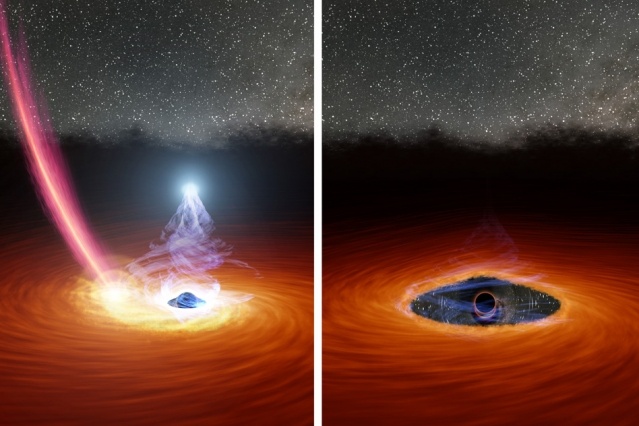In March 2018 astronomers watched a massive black hole surge in brightness. Then over the following year, its ring of light dimmed to near-invisibility before regaining its former strength. The potential culprit? The black hole swallowing an entire star.
The neighborhood of a black hole is, to put it mildly, a nasty place. And it’s especially bad near the biggest black holes in the universe, known as supermassive black holes. As gas and dust falls towards the event horizon, it crowds together in a tight, bright ring of swirling energies, ripping itself apart in a tremendous inferno. This disk spins and spins, generating massive magnetic and electric fields that twist the distort the flows of gas.
Sometimes those magnetic fields – especially the ones near the monster itself – become so entangled that they snap like over-stretched rubber bands, releasing a flood of deadly X-ray radiation. Astronomers observe this radiation in the form of a “corona”, haloing the black hole in the center.

So all this is suitably awesome, but something went awry with one particular monster black hole known as 1ES 1927+654. In March 2018, astronomers with the All-Sky Automated Survey for Super-Novae (ASSASN) watched as this otherwise-normal system surged in brightness by over 40 times.
But after that flare-up, follow-up observations with NASA’s NICER, an X-ray telescope on the International Space Station, showed a steep decline in brightness. Over the course of a single year, the X-ray corona dimmed by a factor of over 10,000.
Slowly, ever so slowly, the black hole’s corona returned to its former glory.
The only explanation that makes sense, as reported in a recent paper published in The Astrophysical Journal, is that the black hole ate an entire star.
As the star approached the embrace of the black hole’s event horizon, the extreme gravity ripped it to shreds, releasing the burst of energy that ASSASN spotted. But as it spiraled inwards, the star was like a nuclear bull in a china shop, smashing through the complex webs of magnetic fields lines. Without the magnetic fields to shape and funnel the surrounding gas, all activity near the black hole ceased.
It wasn’t until years later (well after it finished its stellar meal) that the black hole could reassert control over the situation and replace its corona.
At least, that’s what we think. When it comes to some of the most energetic and complex events in the universe, sometimes a good guess is all we’ve got.

